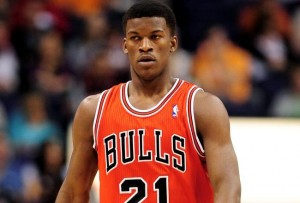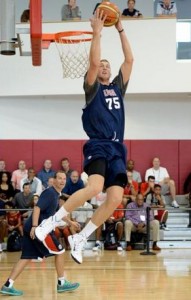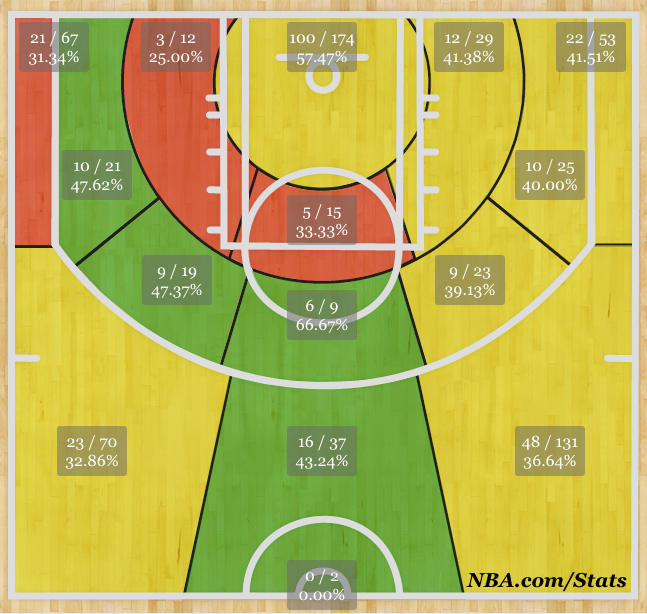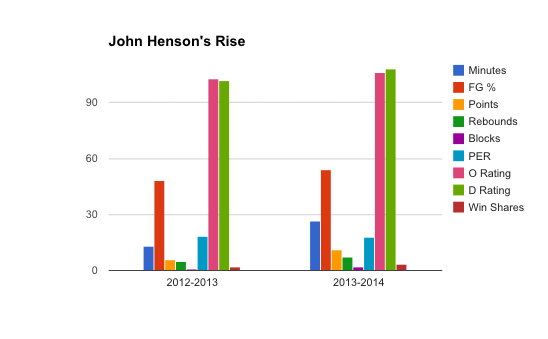 Training camps are over, exhibition games have begun, and the excitement is palpable as we build towards the 2014-2015 season with players who should have breakout or standout seasons.
Training camps are over, exhibition games have begun, and the excitement is palpable as we build towards the 2014-2015 season with players who should have breakout or standout seasons.
Here are five players in the Eastern Conference – one at each position, no rookies – who will take the next step towards greatness this upcoming season. Tomorrow, the West.
Giannis Antetokounmpo, PG, Milwaukee Bucks
The Greek Freak isn’t a point guard, you say? New Milwaukee coach Jason Kidd must not have gotten the memo. Antetokounmpo handled the ball for long stretches during Summer League in July, dazzling and amazing writers and fans and scaring the bejeezus out opposing coaches and scouts.
He athletically weaved his way to the rim nearly at will, running the floor really well. His decision-making needs work, but he can already penetrate and get to the hole when he pleased based on his play in Las Vegas.
If working with a future Hall-of-Famer in Kidd isn’t enough tutelage for Antetokounmpo, it appears likely that already Hall of Famer Gary Payton will also be working with him on his point guard skills during training camp and the preseason.
Antetokounmpo, who has the most potential of any player in the league, doesn’t turn 20 until Dec. 6. He is extremely raw and his advanced numbers (10.8 PER, a net rating of minus-15 per 100 possessions) aren’t very good, but you could see the bursts and glimpses of sheer brilliance on the floor. He’s already knocking down 34.7 percent of his threes and he figures to play more than 24.6 minutes per game under Kidd.
Look for Antetokounmpo to make big strides this year offensively, including running some point guard and getting to the basket a whole lot more. Just sit back and watch him grow.
Tim Hardaway Jr., SG, New York Knicks
No Knicks player will benefit from Phil Jackson’s Derek Fisher’s new triangle offense more than Hardaway, who had a dazzling 112 offensive rating (team’s points scored per 100 possessions while on the floor) and shot 36.3 percent from three in his rookie season. Based on his shot chart from last season, Junior already has some sweet spots on the floor where he’s a deadly spot-up shooter, as shown in his shot chart from 2013-2014.
Though Hardaway has to work on his corner threes, he is already a very proficient mid-range shooter and excels from the top of the key beyond the arc. His defense still needs a lot of work, but Hardaway should have even better numbers with New York’s improved ball movement and his progression into an impact offensive threat.
Jimmy Butler, SF, Chicago Bulls
 With Derrick Rose back in the picture at point guard, Butler now gets to relax and not have to be the focal point of the Bulls’ offense from the perimeter. To say Butler was overworked last season is the understatement of the week.
With Derrick Rose back in the picture at point guard, Butler now gets to relax and not have to be the focal point of the Bulls’ offense from the perimeter. To say Butler was overworked last season is the understatement of the week.
Butler’s 38.7 minutes per game tied him with Carmelo Anthony for the highest number in the league. Yet he still managed to finish 13th in the NBA in defensive rating, allowing just 100.4 points per 100 possessions, and eighth in defensive win shares.
| Jimmy Butler- League Leader | Stat | NBA Rank |
| Minutes Per Game | 38.7 | T1 |
| Steals Per Game | 1.9 | T4 |
| Defensive Win Shares | 4.6 | T8 |
| Steals | 127 | 12 |
| Defensive Rating | 100.4 | 13 |
There’s no question Butler already is one of the finest wing defenders in the game, but where he will really improve this season is on offense. With Rose shouldering the offensive load, Butler could go back to the “quality over quantity” approach that allowed him to shoot 46.7 percent from the field and 38.1 percent from three in 2012-2013, as opposed to the disappointing 39.7 percent and 28.3 percent he posted last season.
Case in point: When playing at least 40 minutes last season – which Butler did a staggering 38 times – he shot 39 percent from the field and 24.7 percent from three with a 104 offensive rating. When he played between 30 and 39 minutes, according to Basketball-Reference, he shot 32.7 percent from three with a 111 offensive rating. Once Butler’s minutes are properly managed, look for him to have an offensive breakout in 2014-2015.
Mason Plumlee, PF, Brooklyn Nets
 Based on Plumlee’s stint with Team USA this summer in the FIBA World Cup, it’s hard to believe he played just 18.2 minutes per game last season. He was mismanaged by Kidd and rode the bench for too long that season. If he gets more playing time under new coach Lionel Hollins, look for Plumlee to not only excel in Brooklyn but become a borderline All-Star in the process.
Based on Plumlee’s stint with Team USA this summer in the FIBA World Cup, it’s hard to believe he played just 18.2 minutes per game last season. He was mismanaged by Kidd and rode the bench for too long that season. If he gets more playing time under new coach Lionel Hollins, look for Plumlee to not only excel in Brooklyn but become a borderline All-Star in the process.
Plumlee hit a sensational 65.9 percent of his shots and averaged 4.4 rebounds, 0.8 blocks and 0.7 steals in just over 18 minutes. His PER (19), true shooting percentage (.670), offensive rating (121), net rating (plus-17) and win shares per 48 minutes (.176) were off the charts.
What’s even more encouraging is how Plumlee excelled past the All-Star break, when injuries mounted and he started most of the games he played. Take a look at his improvement.
| Plumlee | Starts | MPG | FG% | PPG | RPG | BPG | ORate | DRate | NetRate |
| Before Break | 1 | 15.6 | 63.2 | 6.2 | 3.3 | 0.76 | 118 | 107 | 11 |
| After Break | 21 | 22 | 68.4 | 9.1 | 6 | 0.83 | 121 | 106 | 15 |
In just six more minutes per game, Plumlee’s productivity increased and his efficiency got even better, although he has to work on his free throws. It’s easy to envision Plumlee being a regular double-double player if he plays at least 30 minutes. If used correctly, Brooklyn could finally have a healthy young star to look forward to after being disappointed by Brook Lopez and Deron Williams.
John Henson, C, Bucks
It’s another young Buck, and another young player who thrived with more playing time and more freedom on the floor. With Larry Sanders injured, Henson had a standout 2013-2014 season despite playing just 26.5 minutes per game and coming off the bench in 47 of his 70 appearances.
Look at his improvement with an extra year of experience and more than twice the minutes played per game.
| John Henson | Minutes | FG % | Points | Rebounds | Blocks | PER | O Rating | D Rating | Win Shares |
| 2012-2013 | 13.1 | 48.2 | 6.0 | 4.7 | 0.7 | 18.2 | 103 | 102 | 1.9 |
| 2013-2014 | 26.5 | 53.8 | 11.1 | 7.1 | 1.7 | 17.9 | 106 | 108 | 3.3 |
While his minutes more than doubled, his efficiency remained nearly the same and his per-game numbers skyrocketed. Like Plumlee, it wouldn’t be the least bit surprising if Henson averaged a double-double with 30 minutes nightly. With Antetokounmpo, Henson, rookie Jabari Parker and a healthy Sanders, Milwaukee already has a nice youthful nucleus with which to work.
Check out the Western Conference’s breakout team on Sunday here at SheridanHoops
Shlomo Sprung is a national columnist for SheridanHoops who loves advanced statistics and the way they explain what happens on the court. He is also the web editor of the Brooklyn Daily Eagle. A 2011 graduate of Columbia University’s Journalism School, he has previously worked for the New York Knicks, The Sporting News, Business Insider and other publications. You should follow him on Twitter.


For Mason Plumlee to excel, he’ll need to play significant minutes at PF, alongside Lopez. So far Coach Hollins plans to start KG alongside Lopez. That didn’t work well last season. I would expect Lopez to play about 30 mpg, leaving only about 18 mpg for the backup Center.
Plumlee has a long way to go, to have offensive moves of a non-stretch PF, but since Lopez can play as a stretch Center, they should be able to coexist.
On the Tim Hardaway Jr. slide… Offensive rating is not points scored per 100 possessions. It’s how many points your team scores while you’re on the court. Same with defensive rating. Would be actually impossible for 5 starters to all average 100+ points per 100 possessions.